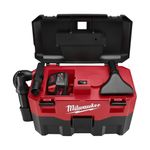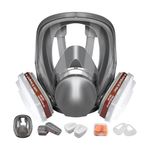I need to install an outside drain at the bottom of a driveway which slopes towards the house. The drain goes to the sewer.
Does this drain need to be vented?
Fine Homebuilding Recommended Products
All New Bathroom Ideas that Work
Everyone wants their bathrooms to be beautiful, but few know the challenge of arranging all the fixtures, storage, and convenience of a great bathroom into one of the smallest space in our homes. This book has hundreds of ideas to inspire you.
Bosch Wall Scanner (GMS 120)
This wall scanner can locate wood and metal studs with respectable accuracy.
Milwaukee Cordless Shop Vac (0880-20)
This sleek, sturdy little vac is ultra compact but has plenty of power and the quietest operation.
100-ft. Tape Measure
Laying out mudsills and foundations for new homes and additions requires a bigger tape measure than your everyday carry.
Respirator Mask
A full-face respirator prevents fog up and is more comfortable than constantly replacing particle makes that get fouled or sweaty and is ideal for the pro installer.




















Replies
Is it a combined sewer or a storm sewer?
It is a sanitary sewer, so now it will be a combined sewer. If I do have to vent it, how far can the vent be from the drain?The city is Portland, OR, and because we get a lot of rain, they don't want rain in the sanitary, but they said for driveways that slope towards the house, it is ok. They said if I tried to inject it underground, it would be difficult because I would need to go through DEQ or EPA and clean it first, being from a driveway with possible oil, antifreeze, etc.
Shouldn't need a trap or a vent, it would seem to me. It's outside. You vent your house outside ... Manholes for sewers vent outside. I'm not a plumber, though.
BTW you don't get a lot of rain ... NawLeans gets a lot of rain. You get a little rain a lot. Not a lot of rain a lot. You get like what 30 inches a year ... NawLeans gets 6 inches in a day. It's a myth that it rains a lot in the NW/coast (except the Olympic Penninsula).
IMO it needs a trap and vent, if it's feeding a sanitary sewer.
As I stood before the gates I realized that I never want to be as certain about anything as were the people who built this place. --Rabbi Sheila Peltz, on her visit to Auschwitz
Then the manhole in the street should need a trap and a vent. Also a trap and vent on the 3-4 inch through your roof. Where would you run the vent ... over by the neighbor's house? It makes no sense to me ... unless I'm missing your point.
The manhole in the street is not immediately next to a inhabited building, nor it is typically in a depression where gasses can collect. And sanitary sewer manholes are generally sealed, at least moderately well.
As I stood before the gates I realized that I never want to be as certain about anything as were the people who built this place. --Rabbi Sheila Peltz, on her visit to Auschwitz
We (at least I) don't know the location of this driveway drain relative to the house. Your point is reasonably taken, but you don't describe where/how you would vent it. Placing a vent next to the drain does zip. As others and you have said, this is storm water and if storm water isn't the same as the sewer at that city, then you should be draining to storm sewer.
In the NW, you frequently cannot allow storm water to leave your property. You have to retain it on site; can't drain to the street and can't drain to the neighbors.
It's pissy rain a lot of the time. Just gray skies."There are three kinds of men: The one that learns by reading, the few who learn by observation and the rest of them have to pee on the electric fence for themselves."Will Rogers
>>It is a sanitary sewer.......If I do have to vent it, how far can the vent be from the drain?<<
Now a combined sewer with the blessing of the city.
I am not a plumber, but I will pass on my observations from my experience with combined sewers. I cannot comment on a distance from the vent.
1) You will need to install a trap - otherwise you will be greeted at the garage door with the lovely smell of sewer gas. That is the purpose of a trap - blocking the gas.
2) All of the rain water leaders on the houses here had a trap just inside of the crawlspace or basement walls - piping with appropriate pitch which connected inside of the basement / crawlspace to the main sewer line out of the house.
The main sewer line was vented in a normal fashion, there were no separate vent lines for each of the rain water leaders. No "dedicated" vents like you would find at a sink or toilet were installed.
Purpose of venting is twofold - to route sewer gas out of the house away from "smell-able" zones and to promote drainage within the pipe itself by admitting air.
It would seem to me that you will need both trap and vented drain line (possibly the main house vent is sufficient).
Can't help you with a linear distance - the closer, the better is a general rule.
Shout out to Plumb Bob maybe?
Jim
Never underestimate the value of a sharp pencil or good light.
The vent also prevents the trap from being sucked dry.
As I stood before the gates I realized that I never want to be as certain about anything as were the people who built this place. --Rabbi Sheila Peltz, on her visit to Auschwitz
>>....prevents the trap from being sucked dry.<<
Correct.
It performs this task by admitting air into the drain line (my post .15 or so).
Jim
Never underestimate the value of a sharp pencil or good light.
I am not a plumber but my father was and I worked with him alot. And I just finished up 25 years on our city council, the last 4 as mayor, and we are in the process of separating rain water from sanitary. I have worked with the civil engineers and contractors on this project. And the point is.......
I can't see any municipality wanting to dump rain water down a sanitary sewer, especially for the reasons of possible oil/gas drippings. Where does the storm drains along a curbed road way go????? The potential amount of pollutant in a driveway no way comes near to the gas, oil, road salts, ect... that goes down a roadway drain.
Along as you have the blessings and permits of the city!!!!
And when the sanitary systems are over charge in a heavy rain and you basement fill with sewage, have fun!!
it is vented its outside, or do we vent it back inside. it goes to storm sewer, you tie into saintary sewer they will drop the treatment plant on your head.
If it is drained into the sanitary sewer, I'd strongly suggest that things be planned so it can be DISconnected some time in the future should the rules change. It's very likely that, 10 years down the road, one would not be able to sell the house with the drain connected to a sanitary sewer.
As I stood before the gates I realized that I never want to be as certain about anything as were the people who built this place. --Rabbi Sheila Peltz, on her visit to Auschwitz
I agree with you on that one!!!!!
Our city kicked around a check list of improvements to a property to be done before a sale, but backed off. IE: seperation of weep tile/sump pumps and repair sidewalks, ect... Didn't want to hurt housing sales.
Rules to the game may change any time, may that change as ez as poss!!
This makes my head spin. Why in the world should outside water ever be introduced into the sanitary sewer unless it's to assist your new 1.28 gallon toilet with getting solid matter out to the street? I'm trying to picture the back up during a very heavy rain.
Yeah, around here it would be a big no-no, but the rules differ elsewhere.
As I stood before the gates I realized that I never want to be as certain about anything as were the people who built this place. --Rabbi Sheila Peltz, on her visit to Auschwitz
My seat of the pants thought:
If it goes to a storm sewer - no trap, no vent.
If it goes to a sanitary sewer - needs a trap and probably a vent.
Jim
If it's a sanitary, you better check to see if it's legal to dump storm water into!!!
Here it's a big no no, and the Gods with take revenge on you and flood your basement!!!!
>> If it's a sanitary, you better check to see if it's legal to dump storm water into!!!<<
My city required storm water to be drained into the sanitary / combined sewer until about 5 years ago -- now it's a no-no. If the water was captured by a gutter / downspout - it had to be plumbed into the sanitary sewer.
But you are right -- check local ordinances!
Don't want to anger the gods.......
JimNever underestimate the value of a sharp pencil or good light.
Been there!
Our city operated its own treatment plant until the 70’s. Then all run off ran into the sanitary, “the solution to pollution is dilution” City abandoned the plant and connected to the county and we are now metered for usage and pay the county. In a dry month our average fees per month runs approx. $18 grand. On a heavy rain month the county fee can run as much as $80 grand.
This is a city of 1 mile square and pop. Of approx. 5,400, that’s a lot to pay for treating rain water.
We had one area where lift pumps ran continuously when the rain started. City placed meters on that lift station and compared the flow to the weather rain fall charts. That area flow increased just minutes after the rain started.
We are now in the midst of a multimillion $$$ entire city I&I program, (Inflow & Infiltration).
With the high cost of treatment, won’t take long for the payback!!
I would agree with the others. Even if it's currently legal to drain into a sanitary sewer, don't do it if at all possible.
7 responses, no one read the msg ..
it's a storm drain, no, a vent isn't necessary, I would recommend a check valve between the street and your catch basin, as well I prefer a long trough type drain in front of the garage instead of a catchbasin. If you are in a cold climate, embed heating cable in the concrete when the trough is poured. Sloped laneways are a pane, I'd never have one again!
We read the message, and it said "sewer". That could be a storm drain, but could (perhaps more likely) be a sanitary sewer.
As I stood before the gates I realized that I never want to be as certain about anything as were the people who built this place. --Rabbi Sheila Peltz, on her visit to Auschwitz
>>7 responses, no one read the msg ..
it's a storm drain, no, a vent isn't necessary,...<<
Not to beat up on ya, but, uhhhh, didn't I say that in post ####.3? You might want to check.
>>If it goes to a storm sewer - no trap, no vent.<<
By the way, the OP only said that it drains to a "sewer" with no differentiation between storm sewer vs sanitary sewer - could be either depending upon locale.
Potentially offensive comments about reading the responses withheld......:^)
Jim
Never underestimate the value of a sharp pencil or good light.
Edited 9/18/2009 9:31 am ET by JTC1
Have another cup of coffee and calm down.
We all read it, evidentually better than you have read the other post.
IMO, all the replies gave very good words of wisdom without being sarcastic.
1 more note, in my city you need a permit to do a repair or connect to a storm or sanitary sewer.
My coffee is getting cold!
Originally >>The drain goes to the sewer.
Then>>7 responses, no one read the msg ..
>>it's a storm drain
I was gonna offer comments, but (i) you've got to get your story straight, and (ii) people read your message and you either don't knoiw enough to understand that you got answers or you aren't reading what was written.
In either case, from my point of view: go pay someone for an answer. (That answer is in lieu of another one that comes to mind.)
"Ask not what the world needs. Ask what makes you come alive... then go do it. Because what the world needs is people who have come alive."
Howard Thurmanhttp://rjw-progressive.blogspot.com/
Bob,
OP was wilf not wane
Thought you ought to know.......
JimNever underestimate the value of a sharp pencil or good light.
Opps, sorry, whoever...
Actually, since I'm never wrong, wiff and wane are obviously the same poster <!---->)<!---->
"Ask not what the world needs. Ask what makes you come alive... then go do it. Because what the world needs is people who have come alive."
Howard Thurmanhttp://rjw-progressive.blogspot.com/
Edited 9/18/2009 7:39 pm ET by rjw
Actually, since I'm never wrong, wiff and wane are obviously the same poster <!---->)
Well at least we got that cleared up! :^)
Jim<!---->Never underestimate the value of a sharp pencil or good light.
I'm trying to imagine a vent on an outdoor trap. Any chance you need a new flag pole?
I'm trying to imagine a vent on an outdoor trap. Any chance you need a new flag pole?
ROAR!
Congratulations!
davidmeiland receives the BT 'Clear Thinkin' Award.
Saaalute!!!View Image View Image
I wouldn't trap this because the trap will freeze unless it is buried deeply. Venting a trench drain (through the house to above the roof???) seems really awkward. Unless you have huge amounts of water pipe it to a dry well - the notion that auto fluids are going to contaminate this any more than storm water runoff from a road is simply nonsense.
You can see right here that no permits are needed for a drywell - http://www.portlandonline.com/shared/cfm/image.cfm?id=166420
You can see right here that Portland is discouraging transporting storm water off site (as is nearly everyone else) - http://www.portlandonline.com/bes/index.cfm?c=43081 - they actually have a downspout disconnection program (!)
Jeff
Besides - look what your city is promoting (it's not CSOs): http://www.portlandonline.com/BES/index.cfm?c=34598
View Image
Edited 9/18/2009 11:37 pm ET by Jeff_Clarke
We don't know several things about this scenario: Sanitary or storm sewer, where does the OP live (and how cold does it get), how is the drive situated?If it's like some I've seen, with embankments on both sides of a "tuck-under" garage, then one must consider the hazards (if sanitary sewer) of sewer gasses collecting in the low area. This is both an explosion hazard and a health hazard.
As I stood before the gates I realized that I never want to be as certain about anything as were the people who built this place. --Rabbi Sheila Peltz, on her visit to Auschwitz
Post #13 - It is a sanitary sewer, so now it will be a combined sewer.
Post # - City of Portland OR
Thank you for all the replies.I spoke with someone from the city. They are approving an outside drain which goes to the sanitary sewer. This is unusual because they do normally want storm water handled onsite, but potential basement flooding preempts that and there isn't room for a dry well without extensive excavation to get it to another area.No vent is needed because it is outside, but at least a 12"x12" catch basin is which acts as trap and clean out is necessary. It is also necessary to install a back flow preventer next to the catch basin. I thought that was interesting because it can also prevent sewer from the house from coming up through the catch basin.cheers,
Wilf
The backflow preventer will perform some of the functions of a trap, more or less.Do note what I said about this being in a low spot with embankments on both sides. If that's the scenario then sewer gas could build up in the "valley" and cause problems.Also observe what I said about making this setup reversible, should they change their mind in the future.
As I stood before the gates I realized that I never want to be as certain about anything as were the people who built this place. --Rabbi Sheila Peltz, on her visit to Auschwitz
Your local inspector may either require or prohibit the trap and/or the vent. His requirement may or may not make perfect sense, but you will probably have to go with it, either way.
If you are allowed to do as you think best, then I recommend installing a trap for the catch basin or trench drain (trench drain is preferable for a driveway that slopes toward the garage). Make the trap the same diameter pipe as the sewer itself, probably 4", but NOT installing a vent if it's going to be unsightly or impractical. Here's why:
As others have correctly said, vents are installed to protect the trap from siphoning (negative pressure), or "burping" (positive pressure). The likelihood of either happening in your case is extremely remote. This is because the 4" line would have to be running completely full to shut off the line from air in the top of the pipe, air which communicates with vented lines in your house, or air in the main sewer. There is no way the drainage from your house could be enough to make a 4" line run full, and the catch basin itself, in a downpour, might conceivably cause the pipe to run full, but the "tailflow" of the driveway at the end of the storm, would refill the trap.
Even supposing the worst happened once in 20 yrs or so--the "worst" would simply be that you would smell sewer gas, and would have to refill the trap seal by pouring a little water in it. If you forget, the next rain will do it for you.
And before anybody cries foul (bad pun) about the danger of sewer gas, your sewer line is not connected to a septic tank where a lot of sewer gas can develop and collect. You are connected to the City sewer that flows quickly to the treatment plant, and is carried there by a large amount of diluting water, which further reduces the concentration of material that can generate dangerous sewer gases. Granted, it smells bad, but you need not worry about explosions or poisoning from an outdoor drain, even if the trap were to siphon by some near-impossible combination of events.